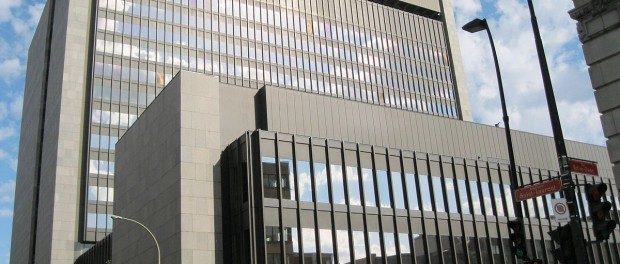The Eighteen Floors of Justice & Other Quebec Curios
 The Palais de justice, located at 1 Notre Dame in Old Montreal. Photo credit: Jean Gagnon/Wikimedia Commons.
The Palais de justice, located at 1 Notre Dame in Old Montreal. Photo credit: Jean Gagnon/Wikimedia Commons.
Quite unsurprisingly, there seems to be no readily apparent gift shop at the Palais de justice de Montréal, since by most standards probably less than half of the people walking into the courthouse would want a souvenir as they walk out. Jokes aside, the Palais de justice is a remarkable structure, both architecturally and in terms of the justice system it houses.
The eighteen floors of the Palais de justice house the two main courts of Quebec that serve the Montreal area, the Superior Court and the Court of Quebec. The Court of Quebec, the court that deals with most civil litigations, as well as criminal and youth cases, has its roots back in the Act of Quebec in 1774, the act that re-established French civil law for most domestic cases and English common law for criminal cases. The Court of Quebec in its present form goes back to 1988 to when the civil courts and the provincial criminal courts united forces. The Superior Court, on the other hand, has its roots in a law written just before Confederation that confers the power of the federal government to name judges that will deal with matters in the province that aren’t given to other courts. This means that the Superior Court, by definition, basically deals with anything the Court of Quebec doesn’t have explicit jurisdiction over. This is poorly defined on purpose to allow as much leeway as possible.
Built in 1965 after architectural plans by Pierre Boulva and Jacques David (not the painter), the Palais de justice is not the first courthouse of Montreal. The first was Édifice Lucien-Saulnier, built in 1851, which is now the centre for municipal administration. The second, Édifice Ernest-Cormier, is now the Court of Appeals building. Many decisions of the Court of Quebec and the Superior Court are now available online, with both paid databases for professionals as well as free databases intended for the public, the most pertinent example of such a database being the official judicial database SOQUIJ (formerly Azimut) that services the needs of both professionals and public alike.
As of the current time of writing, SOQUIJ has selected for publication 3699 judgements from the Court of Quebec and 2084 judgements from the Superior Court since January 1 of this year.





